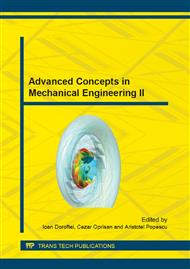p.183
p.189
p.195
p.201
p.205
p.211
p.217
p.223
p.231
Qualitative Estimation Criterion of Direct Injection Diesel Engines Performance Prediction for Stationary and Industrial Applications
Abstract:
Our approach is to define as accurately as possible, the opportunities of forecasting the environmental and energetically qualities of direct injection Diesel engines for stationary and industrial applications. This research requires the validation of new energy solutions or injection process. Knowing that test bench research of internal combustion engines is a task that requires highly qualified personnel and very expensive equipment for investigate the combustion process, a research program to define the best technical solution involves significant costs. The energetically solution of an internal combustion engine, similar to those examined in this paper, is defined by the following guidelines and parameters: - Control of mixture formation; - Compression ratio; - Average swirl intake number channel; - Geometry of the intake and exhaust cams; - Diagram of distribution; - Drive cam type injection pump; - Geometry of the combustion chamber; - Type and nozzle geometry (sack configuration and l / d ratio ); - Needle stroke; - The diameter and length of the injection pipe; - Amount of injector opening pressure (for hydraulic injectors); - Type of delivery valve; - Time of injection. Based on experience gained during the test at the test bed, we proposed a criterion for assessing qualitative performance of Diesel class discussed above. This criterion refers to environmental and energetically performance, as a prediction of performance at nominal regime, after shorten tests with cold engine.
Info:
Periodical:
Pages:
205-210
Citation:
Online since:
October 2014
Authors:
Price:
Сopyright:
© 2014 Trans Tech Publications Ltd. All Rights Reserved
Share:
Citation:


